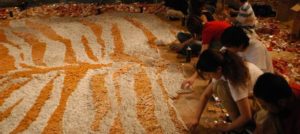 By Peter Galuszka
By Peter Galuszka
The history of Virginia is intertwined very tightly with that of tobacco.
The Golden Leaf boosted the two colonies from their earliest days. One of the first acts of the new colonial legislature in the Old Dominion was establishing price supports for tobacco, which was used a currency and was the state’s most important export product. The first machine to roll cigarettes was invented in Richmond, creating an entirely new industry. One of the last remaining major cigarette factories is in the capital
With this history in mind, and if you looking for something to do on a weekend, you might consider driving down to Richmond to see the new “Xu Bing: Tobacco Project” exhibit at the newly renovated Virginia Museum of Fine Art.
Begun in 2000 when Chinese-born Xu Bing was artist in residence at Duke University, the tobacco project mixes cigarettes, advertising, brand names old books, pay checks and other memorabilia into a highly unusual exhibition exploring the relationship between humans and tobacco.
One work involves 440,000 cigarettes fashioned into the form a 40-foot-long floor rug shaped like a tiger. A wall is covered with old tobacco advertisements. Another curiosity is a 50-foot-long reproduction of a Zhang Zeduan painting from the 10th century, “Along the River During the Qingming Festival,” that has an extra-long cigarette burned down its center.
Xu Bing plays with the ironies of tobacco’s deadly nature and its attractiveness to people. Tobacco kills about 400,000 Americans every year and may kill billion globally in this century, according to the World Health Organization. Xu Bing’s father died of tobacco-related lung cancer.
I asked Xu Bing, who won a MacArthur Foundation “genius” grant in 1999 and who moved to the U.S. in 1990, about this contradiction at a reception this morning. “My show isn’t about propaganda,” he says, “it is about the relationship between tobacco and human beings. It is sort of like love and its effect on people. It is awkward.”
Curiously, after I first posted this blog item, I saw that the Wall Street Journal had run a similar story on Xu Bing with one important difference. The Journal noted that the artist had gone to Altria, the operator of a huge Philip Morris plant in Richmond, to ask for hundreds of thousands of cigarettes. But Altria, a major donor to the VMFA as it is to many Richmond entities, turned him down. So Xu Bing had to try another route.
Last Friday, I had asked a VMFA spokeswoman where Xu Bing had found so many cigarettes and she said that the VMFA had helped locate and pay for them. She did not bring up Altria’s role, most likely because of their funding relationship with the museum. I asked her about it today and she said she wouldn’t have volunteered the information because Altria was not involved in this particular exhibit.
I guess I can understand that, but it does raise many questions, once again, about the tobacco giant’s impact on its new corporate headquarters home of Richmond. Years ago, the American Tobacco Company was such a moneybags that the Medical College of Virginia acted as its chief researcher and promoter. One science historian writing about tobacco research labeled his chapter on the cozy relationship “Sold, American!”
Later, Virginia Commonwealth University got skewered by entering into secretive research contracts with Philip Morris requiring that the cigarette maker be notified immediately if anyone, especially a news reporter, asked about them. VCU later decided not to get into such contracts again.
And now, we’re finding tobacco’s stained hands on art in Richmond. It’s really too bad because the Great Recession has killed off several firms that were major benefactors in the city, leaving basically, Altria, Dominion and MeadWestvaco.
The good news is that Altria’s refusal did not prevent Xu Bing’s show from taking place. It is a good thing that VMFA found another way. Given tobacco’s impact on the region’s history, his show, which is free, is worth a look.


